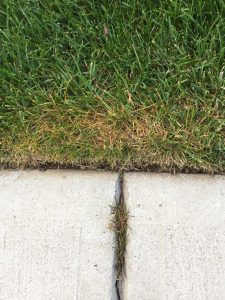Four Fungal Lawn Diseases

Brown patch, summer patch, red thread, and dollar spot are four not-so-fun fungal diseases that infect home lawns. Learn how to identify each and keep them under control with proper cultural practices.
Brown Patch
The first disease is brown patch. As its name suggests, this fungus appears in patches of brown grass from four to twelve inches wide. Brown patch damages the grass blades themselves, which turn brown and form visible spots in your lawn. The spots have grayish-colored edges called smoke rings and can also have a white web-like layer called mycelium. Both of these symptoms are more visible on shorter-mown lawns.
Heat and humidity contribute to the development of brown patch. Your lawn may recover naturally from the disease as the weather cools, but you can also minimize the damage by watering and fertilizing it correctly.

Summer Patch
Another patch disease that causes brown spots is summer patch, which looks similar to brown patch. Summer patch also creates brown spots that can range from four to twelve inches wide, with the worst damage appearing at the patch’s edges. However, summer patch is a fungus that damages grass from the roots up rather than the blades down. You can recognize the disease by dark, rotting roots when you pull a handful of grass.
The summer patch fungus infects roots in the spring, but the brown spots don’t appear until the heat of summer. In addition to good irrigation and fertilization practices, proper mowing height can help prevent the disease in your lawn.

Red Thread
Red thread is a fungal turfgrass disease that can strike pretty much any time during the year. However, conditions in the spring and fall, which typically include prolonged periods of cool and wet weather, are perfect for red thread. The pathogen prefers conditions that promote slow turf growth, and long periods of cool and wet weather do just that. Infected turfgrass areas appear as tan or bleached-white circular patches, with red, thread-like fibers (sclerotia) present among the grass blades.
Maintaining balanced fertility throughout the growing season is critical for controlling red thread. Balanced fertility encourages turfgrass growth and thus discourages the development of red thread. Using slow-feed nitrogen fertilizers will help balance fertility. Other cultural practices, such as annual aeration, proper mowing heights, and mowing frequency (never remove more than 1/3 of the total blade of grass), must also be followed to help reduce the likeliness of a red thread outbreak.

Dollar Spot
Dollar spot is the third disease that can cause brown spots in your lawn. Compared to brown patch and summer patch, dollar spots create smaller spots ranging from two to six inches wide. These patches consist of damaged grass blades with light brown spots. After a heavy dew, patches of dollar spot may also develop a layer of mycelium.
Nitrogen deficiency contributes to dollar spot development, so proper fertilization is a good way to minimize damage. Again, good irrigation and mowing practices help protect your lawn from the disease as well.








